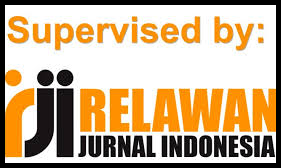ANALYSIS OF FARMERS' ATTITUDES TOWARDS THE IMPLEMENTATION OF CROPPING SYSTEMS RICE FIELD RICE PLANTATION IN SENANING VILLAGE PEMAYUNG DISTRICT
DOI:
https://doi.org/10.22437/jalow.v8i1.43057Keywords:
Planting System, Jajar Legowo, attitudes towards, cropping systemAbstract
This study aims to (1) find out the general description of the implementation of the jajar legowo planting system in Senaning Village, Pemayung District, (2) find out the attitude of farmers towards the implementation of the jajar legowo planting system for rice fields in Senaning Village, Pemayung District, (3) find out the relationship between farmer attitudes towards the jajar legowo planting system for rice fields in Senaning Village, Pemayung District. This study was conducted in Senaning Village, Pemayung District. The location was determined intentionally (purposively) with the consideration that in this research area most farmers run rice fields by implementing the Jajar Legowo planting system. The determination of respondents was carried out using the census sampling technique with a total of 62 respondents. The analysis test used was descriptive and non-parametric statistical test with the Chi-Square (x2) method with a contingency of 2 x 2.
Based on the results of the study, it was found that the cognitive attitude of farmers had an effectiveness level of 90.3%, an affective attitude of 88.7% and a conative attitude of 88.7%. Which means that the cognitive attitude is higher and is able to influence the affective and conative components. It is concluded that farmers agree with the implementation of the Jajar Legowo planting system for lowland rice fields. This means that there is a real relationship between farmers' attitudes towards the implementation of the jajar legowo planting system for lowland rice fields in Senaning Village, Pemayung District
Downloads
References
Azwar. (1995).Human Attitudes: Theory and Measurement Second Edition.Yogyakarta: Offset Student Library.
Punamaningsih. 2006. Rice on the Characteristics of Rainfed Paddy Fields. Universits Brawijaya.Malang Purnamaningsih, R. 2006. Callus Induction and Regeneration Optimization of Four Rice Varieties Through In Vitro Culture. Center for Research and Supervision of Agricultural Biotechnology and Genetic Resources. Bogor. Agro Biogen Journal, 2(2):74-80.
Khumairoh, U., Teixeira, H. M., Yadav, S., Schulte, R. P. O., van Wijk, M., Groot, J. C. J., & de Boer, I. J. M. (2024). Linking types of East Javanese rice farming systems to farmers’ perceptions of complex rice systems. Agricultural Systems, 214, 103706. https://doi.org/10.1016/j.agsy.2024.103706
Chang, S. H. E., Benjamin, E. O., & Sauer, J. (2024). Factors influencing the adoption of sustainable agricultural practices for rice cultivation in Southeast Asia: A review. Agronomy for Sustainable Development, 44, 28. https://doi.org/10.1007/s13593-024-00960-w
Connor, M., de Guia, A. H., Pustika, A. B., Sudarmaji, & Williams, S. (2021). Rice farming in Central Java, Indonesia—Adoption of sustainable farming practices, impacts and implications. Agronomy, 11(5), 881. https://doi.org/10.3390/agronomy11050881
Gunawan, E., Darwis, V., Syukur, M., et al. (2022). Farmers' perception, awareness, and constraints of organic rice farming in Indonesia. Open Agriculture, 7(1), 31–41. https://doi.org/10.1515/opag-2021-0195
Stuart, A. M., Devkota, K. P., Sato, T., Pame, A. R. P., & Singleton, G. R. (2018). On-farm assessment of different rice crop management practices in the Mekong Delta, Vietnam, using sustainability performance indicators. Field Crops Research, 228, 76–85. https://doi.org/10.1016/j.fcr.2018.08.018
Srisopaporn, S., Jourdain, D., & Perret, S. R. (2015). Adoption and continued participation in a public Good Agricultural Practices program: The case of rice farmers in the Central Plains of Thailand. Technological Forecasting and Social Change, 96, 242–253. https://doi.org/10.1016/j.techfore.2015.03.016
Alexander, K. S., Parry, L., & Thammavong, P. (2018). Rice farming systems in Southern Lao PDR: Interpreting farmers' agricultural production decisions using Q methodology. Agricultural Systems, 160, 1–10. https://doi.org/10.1016/j.agsy.2017.10.006
Schreinemachers, P., Afari-Sefa, V., Heng, C. H., & Blum, M. L. (2015). Safe and sustainable crop protection in Southeast Asia: Status, challenges and policy options. Environmental Science & Policy, 54, 357–366. https://doi.org/10.1016/j.envsci.2015.07.017
Tekken, V., Spangenberg, J. H., Burkhard, B., Escalada, M., & Heong, K. L. (2017). “Things are different now”: Farmer perceptions of cultural ecosystem services of traditional rice landscapes in Vietnam and the Philippines. Ecosystem Services, 25, 153–166. https://doi.org/10.1016/j.ecoser.2017.04.010
Berg, H., & Tam, N. T. (2012). Use of pesticides and attitude to pest management strategies among rice and rice–fish farmers in the Mekong Delta, Vietnam. International Journal of Pest Management, 58(2), 153–164. https://doi.org/10.1080/09670874.2012.672776
Chouichom, S., & Yamao, M. (2010). Comparing opinions and attitudes of organic and non-organic farmers towards organic rice farming system in North-Eastern Thailand. Journal of Organic Systems, 5(1), 25–35. http://www.organic-systems.org/journal/Vol_5(1)/pdf/JOS_Volume-5_Number-1.pdf
Burkhard, B., Müller, A., Müller, F., Grescho, V., Anh, Q., & Sattler, C. (2015). Land cover-based ecosystem service assessment of irrigated rice cropping systems in Southeast Asia—An explorative study. Ecosystem Services, 14, 103–112. https://doi.org/10.1016/j.ecoser.2015.05.005 Lefroy, R. D. B., Bechstedt, H. D., & Rais,
Singleton, G. R., Brown, P. R., & Jacob, J. (2004). Ecologically-based rodent management: Its effectiveness in cropping systems in Southeast Asia. NJAS - Wageningen Journal of Life Sciences, 52(2), 163–176. https://doi.org/10.1016/S1573-5214(04)80011-3
Rerkasem, K., Yimyam, N., & Rerkasem, B. (2009). Land use transformation in the mountainous mainland Southeast Asia region and the role of indigenous knowledge and skills in forest management. Forest Ecology and Management, 257(10), 2035–2043. https://doi.org/10.1016/j.foreco.2008.11.027
Cramb, R. A., Colfer, C. J. P., Dressler, W., & Laungaramsri, P. (2009). Swidden transformations and rural livelihoods in Southeast Asia. Human Ecology, 37(3), 323–346. https://doi.org/10.1007/s10745-009-9241-6
Sato, S., & Uphoff, N. (2007). A review of on-farm evaluations of system of rice intensification methods in Eastern Indonesia. CABI Reviews: Perspectives in Agriculture, Veterinary Science, Nutrition and Natural Resources, 2(54), 1–19. https://doi.org/10.1079/PAVSNNR20072054
Lisson, S., MacLeod, N., Corfield, J., McDonald, C., & Pengelly, B. (2010). A participatory, farming systems approach to improving Bali cattle production in the smallholder crop–livestock systems of Eastern Indonesia. Agricultural Systems, 103(9), 657–674. https://doi.org/10.1016/j.agsy.2010.05.002
Devendra, C. (1997). Improvement of livestock production in crop-animal systems in rainfed agro-ecological zones of South-East Asia. CABI Publishing. https://books.google.com/books?id=2uKRoGYS92gC
Spangenberg, J. H., Escalada, M., Burkhard, B., Tekken, V., & Heong, K. L. (2017). Cultural ecosystem services of traditional rice landscapes: A comparative perception study. Ecosystem Services, 25, 153–166. https://doi.org/10.1016/j.ecoser.2017.04.010

Downloads
Published
How to Cite
Issue
Section
License
Copyright (c) 2025 Mila Amelia, Fendria Sativa, Jamaluddin Jamaluddin

This work is licensed under a Creative Commons Attribution 4.0 International License.











